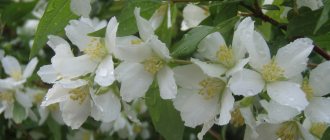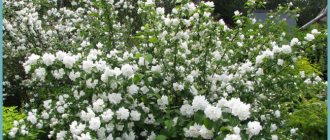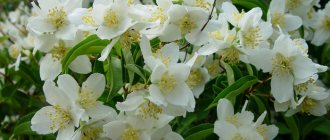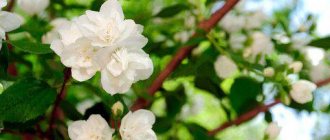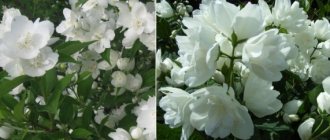The most beautiful and sustainable varieties of mock orange of foreign and domestic origin for cultivation in the middle zone and the Moscow region:
- Mock orange (Philadelphus coronarius) Aureus
- ХVariegatus
- Nana, or Pumilus
- Dame Blanche (White Lady)
Crown mock orange (Philadelphus coronarius)
The most common is the crowned mock orange (Philadelphus coronarius). This is a tall, up to 3–4 m, spreading shrub native to Western Europe. The shoots are brownish-brown with cracking bark. Large light green leaves turn yellow in autumn.
It blooms in late June - early July for more than two weeks.
Flowers are up to 3–5 cm in diameter, non-double, creamy white, collected in racemes.
Chubushnik crown served as the initial form for many varieties and decorative forms.
Mock orange Aureus
- A shrub with a rounded crown, up to 1–2 m high. This form received its name for the bright yellow color of the foliage in spring, which later becomes greenish-yellow.
- Its flowers are single, white, with a strong aroma.
- This mock orange requires a place protected from the wind and mulching around the tree trunk for the winter.
Mock orange Aureus
Mock orange Variegatus
- Bush up to 3 m tall, with green leaves, with a wide creamy-white border.
- For better wintering, this mock orange should be planted in a place protected from the wind.
Mock orange Variegatus
Mock orange Nana, or Pumilus
- Dwarf plants up to 1 m tall, with green foliage and sparse flowering.
What is mock orange and how does it grow?
The Latin name of the mock orange, Philadelphus, comes from the Greek words “love” and “brother”, because the shoots of the bush are located opposite and close to each other. According to another version, the name of the deciduous shrub was given in honor of one of the kings of Ancient Egypt, Ptolemy Philadelphus.
Mock orange belongs to the Hydrangeaceae family. Botanists know more than 60 species of this plant growing in the wild. No more than half of all varieties of garden jasmine are cultivated.
What does mock orange look like?
All types of mock orange are similar in basic parameters. These are shrubs ranging in height from one to three meters with closely spaced opposite shoots. Its leaves are roundly elongated, sometimes pointed, small (5 - 7 cm), more often smooth, but also have jagged edges.
The bark of the plant is predominantly gray. In some types of jasmine it is brownish. In most varieties, the bark darkens on the shoots of the second year of life. For some completely, for others only at the base. The bark peels off on mature shoots.
Flowering of garden jasmine begins in late spring and lasts from a month to two. Its flowers are simple, white, from two cm in diameter, collected in inflorescences from 3 to 9 pieces, bloom on short side branches of the shoot. Most types of mock orange, or garden jasmine, as it is often called, have a delicate aroma. But there are also species without odor. In varietal hybrid varieties, the inflorescences can consist of double flowers and reach a size of more than 10 cm.
Blooming mock orange (jasmine) photo:
The mock orange fruit is not large. The capsules, consisting of several chambers, are filled with small achenes.
In nature, mock orange grows in regions with warm and temperate climates (north of the American continent, East Asia, Europe). The culture prefers the edges of deciduous or mixed forests. It is often found on rock slides and cliffs. Bushes grow one by one or in groups.
How fast does mock orange grow?
Gardeners classify garden jasmine as a fast-growing shrub. It only takes 2 - 3 years from the moment of planting for the height and size of the mock orange crown to reach the maximum for its variety.
Application of mock orange
Jasmine is universal in landscape design. Single bushes perfectly decorate garden gazebos and look original against the background of brick and stone walls of a house and other buildings. Due to the rapid growth of shoots, mock orange is suitable for creating hedges of various heights.
Photo of a single planting of a mock orange bush:
Circumcision
The shrub grows quickly and erratically, requiring regular pruning. The procedure begins strictly after the start of flowering, because flowers form on shoots no younger than two years old, and excessive removal of such branches will spoil the appearance of the plant.
Branches with weak inflorescences and painful-looking branches are cut off by about a third of their length. When choosing a cut location, pay attention to the location of the upper bud. Choose a place so that the top bud is directed not to the center of the plant, but to its outer part, to prevent their growth into the bush.
Every few years it is worth carrying out thinning sanitary pruning, removing the oldest, thickest branches to rejuvenate the plant.
If you follow the simple principles stated above when pruning, then the shrub in your garden will look as attractive as in the photo of a mock orange from professional greenhouses.
Types of mock orange with photos and descriptions
Garden jasmine varieties must be carefully selected for growing conditions. Some of them are not suitable for frosty Russian winters. And although most species quickly grow back after sanitary spring pruning of frostbitten shoots, the main characteristics of mock orange are worth studying before purchasing a seedling.
Ordinary
In nature, this type of garden jasmine grows in the southern regions of Western Europe and the Caucasus. The three-meter shrub blooms earlier than other representatives of the glorious family. Pale or common mock orange (Philadelphus pallidus) is distinguished by bare, erect shoots. The leaves of the bush are pointed, with sparse small jagged edges. Their upper side is dark green, and the lower side is much lighter and covered with fluff. Milky-white simple small flowers, up to 3 cm, flowers collected in brushes of up to 7 pieces each.
The common mock orange became the progenitor of several forms and varieties of shrubs: large-flowered, golden, willow-leaved, double, silver-edged, low.
The hybrid varieties of pale mock orange Virginal, Belle Etoile and Bicolor are very popular among gardeners.
Coronary
The southern European newcomer has taken its rightful place in gardens around the world. Selection of this variety of garden jasmine began in the 16th century.
A bush up to 3 m in height forms a lush crown - up to 2 m in diameter. Even young shoots are covered with exfoliating bark of a red-brown and yellowish hue.
The leaves are deep green, oblong and pointed. Their reverse side is pubescent with veins. Fragrant inflorescences, consisting of 3 - 5 simple creamy-white flowers, cover the bush for 3 - 4 weeks, starting from the 5th year of life.
Philadelphus coronarius (Latin version of the name) is one of the longest-living representatives in its family. According to the description and photo, the crowned mock orange in nature can reach an age of 80 years. Moreover, it blooms for at least 30 seasons.
Breeders have worked a lot on the oldest type of jasmine. Many varieties have been created that differ in flower structure and other characteristics. Among the most famous hybrids, gardeners note Innocence, Variegatus and Aureus.
Fluffy
This type of garden jasmine got its name because of the airiness of the lower leaves. Layered brownish bark covers the shoots only from below. Lush cups of snow-white flowers, collected in inflorescences (7-10 pieces each), are almost odorless. The shrub blooms by mid-summer. This is one of the late-blooming mock oranges.
This type of mock orange became the basis for the creation by Russian breeders of many varieties: Ballet of Moths, Zoya Kosmodemyanskaya, Unusual Pearl, Academician Korolev.
And although hybrids were bred several decades ago, they are still popular among gardeners.
small-leaved
Not only small leaves of about 2 cm are a distinctive feature of garden jasmine. The photo of mock orange does not convey its main feature - its unique strawberry aroma. Gardeners often call this species Strawberry.
A small (1.5 m) bush has an equally compact crown. Simple flowers are arranged singly or in small inflorescences. The bush usually blooms actively. It is covered with a snow-white blanket so much that its erect shoots bend, forming a cascade.
Based on small-leaved jasmine, amazingly beautiful hybrids Snow Avalanche, Ermine Mantle and Avalange were created.
Hybrid
This category includes many interspecific combinations that were created by breeders around the world. Among the most popular varieties, gardeners note French hybrids bred by Lemoine and Russian hybrids by Academician Vekhov, many of which received their own names.
Flower of the hybrid mock orange shrub Minnesota Snowflake in the photo:
By crossing various natural species of mock orange, new varietal characteristics were obtained. The main achievements were the production of two-color varieties of garden jasmine, increasing the flowering period and frost resistance of the crop.
Odorless
One of the tallest shrubs in the genus of garden jasmine. It reaches a height of 4 m, and its crown diameter is about 3 m. The plant is distinguished by long and lush flowering. But its main feature is the absence of aroma. Four- and five-petalled simple flowers are collected in brushes of up to 5 pieces. Their leaf blades are very long for mock oranges. On non-flowering shoots they can be up to 12 cm.
Lemoine
As a result of selection by the French originator Lemoine, the first hybrid with increased frost resistance and unique decorative qualities was developed. Currently, there are about 40 hybrid varieties of garden jasmine from the Lemoine workshop. Most of them are low-growing, reaching a height of no more than 1.5 m. At the same time, the crown of the bushes quickly grows to the same size.
The flowers of French mock orange hybrids are striking in their diversity. Among them there are terry varieties and two-color ones. Shrubs and foliage differ. Oval, ovate and pointed leaves can range from light green to soft golden color. The most popular varieties: Dame Blanche, Snow Avalanche, Avalanche Mont Blanc, Belle Etoile, Pyramidal.
Lemoine was the first breeder who managed to create mock orange with white and purple flowers. Natural specimens have only white or cream inflorescences.
Schrenk
This tall mock orange received its name in honor of the famous Russian scientist and traveler Alexander von Schrenck. In nature, the shrub is found in the Far East and neighboring countries.
The shrub grows up to 3 m in height. The bark on its young shoots is brownish and covered with hairs. But from the second year of life it begins to crack and crumble. In this case, the color changes to grayish-brown.
The leaves of Schrenk's mock orange are ovate and slightly narrowed at the upper edge. Flowering shrub in early June in central Russia. Small (up to 4 cm) flowers with a delicate aroma are collected in clusters of 9 pieces.
Planting, transplanting, care
The most successful period for planting and replanting garden jasmine is autumn (from early September to the first half of October). In spring it is a little more difficult - you need to have time to plant the bush before the buds open. If you plant several mock oranges at once, the distance between them should be from 50 cm to 1.5 m; when planning a hedge, place the bushes at a distance of 50–80 cm.
It is advisable to prepare the hole about 14 days before planting - dig a hole up to 70 cm deep, lay a drainage layer (up to 15 cm) of broken brick or coarse sand on the bottom, and pour the same layer of soil mixture on top.
When planting a seedling, only the root is placed in the ground; the stem from the root collar must remain on the surface, otherwise there is a risk of rotting. After planting, the seedling needs to be watered generously and after a couple of days mulched with a small layer (3–4 cm) of sawdust or peat.
Another useful observation is that mock orange does not like to be adjacent to an apple tree; they have a suppressive effect on each other (allelopathy effect). For many years we wondered why our bush did not grow widely and threw up something resembling tops that bloomed poorly at the very tips. When we decided to replant the bush, everything immediately got better - it blooms well and fluffs up. So don’t go wrong with your choice of landing site. Here he is in the second year of transplantation:
How to care for garden jasmine
Watering.
All types of garden jasmines are sensitive to drought; it is advisable to water them once a week with 2-3 buckets of water per bush. In particularly hot periods and during flowering, daily watering may be required; watch the leaves, they will droop from lack of moisture.
Fertilizers.
In spring, it is recommended to feed the kutas with slurry (no more than 1 bucket in a ratio of 1:10). After flowering, wood ash will help restore strength; just scatter it around the perimeter of the tree trunk before watering.
Trimming.
The first procedure is carried out almost immediately after planting; remove weak branches and slightly shorten the main shoots. After flowering, all weak branches should be cut off, thereby allowing new shoots to develop.
In autumn, side branches form on new branches, which will bloom the following year. In the 3rd year, the young branches will get stronger, and so that they do not lose strength and bloom profusely, the old branches can be cut off to the base. Anti-aging pruning is carried out in early spring (before sap flow begins), sanitary pruning - in autumn. It is not necessary to treat the cut areas with garden varnish; the bark will dry out underneath it.
Transfer.
Based on our experience, mock orange easily tolerates a change of location, but in the first year after transplantation, the bush most likely will not bloom. To begin with, prepare a hole in a new place (as in the case of planting), then proceed to prepare the bush - a day before replanting, water the bush generously, after a day half of the old shoots should be removed to the roots, the rest should be shortened by half - that's it, the bush is ready for transplantation The period of transplantation and planting is the same.
Diseases and pests.
Garden jasmine is resistant to disease, but the most dangerous pests are the green leaf weevil, spider mite and bean aphid. For protection, use folk recipes or biological products.
The best varieties of mock orange
Among the many types and varieties of garden jasmine, you can choose a shrub for your garden that is ideal for its decorative qualities and growing conditions.
Fragrant varieties of mock orange
Most natural varieties of mock orange are fragrant. But breeders have enhanced this quality. If you need garden jasmine with a scent for your garden, then you should pay attention to the varieties Lemoine and Vekhova.
- Snow Avalanche is a miniature French hybrid (up to 1.2 m) that blooms from the end of June. Its tiny flowers emit a strong strawberry scent. The fragrance lasts about 2 weeks.
- Bouquet Blanc - called the White Bouquet. Terry inflorescences with a sweet aroma cover an almost two-meter bush for 3 weeks.
- Gletscher - blooms with double snow-white flowers for almost a month. Large inflorescences emit a scent similar to that of jasmine.
- Alabaster - combines double and single flowers during flowering. Their aroma is strong and pleasant.
- Airborne assault - surprises with drooping colors, similar to parachute domes in the sky. The aroma of this unique variety is strawberry, with a hint of exotic fruit.
- The miniature varieties of the Vekhov selection, Gnome and Dwarf, speak for themselves. From 50 to 80 cm in height, compact bushes emit a unique aroma when flowering.
The most beautiful varieties of mock orange
It is difficult to argue about tastes, especially when it comes to such beautiful plants as mock oranges. Each hybrid is beautiful in its own way. Some are covered with double flowers, while others have an attractive petal shape or flower structure. And the height of splendor are varieties with two-tone colors. After all, absolutely all types of mock orange naturally bloom white or slightly creamy.
- Few people will be indifferent to the Salut variety. A shrub more than 2 m tall during flowering is strewn with inflorescences consisting of fairly large double flowers of a creamy-white color.
- The shoots of Komsomolets are slightly curved upward. Large (up to 4.5 cm) inflorescences cover the bush with a snow-white blanket. Flowers have an interesting structure. The lower petals are rounded and shorter than the upper ones. And the thin inner petals are enveloped by pale yellow stamens.
- Belle Etoile, or Beautiful Star, is a hybrid of the French Lemoine, which bears its name for good reason. The shrub has snow-white simple flowers with a purple center and yellow stamens. Flowering lasts about a month.
- Ballet of Moths is beautiful with its simple asymmetrical colors. During flowering, this lush, powerful shrub has almost no foliage visible.
- Bicolor - distinguished by large, about 5 cm, flowers. Its distinctive feature is the middle burgundy-pink color, against which the yellow delicate stamens stand out brightly.
- Schneeshturm is considered the furriest hybrid. Its flowers - very large and double - cover a three-meter bush for a month.
You can list the unusually beautiful varieties of mock orange for a long time, and every gardener will have his own favorite representative.
Frost-resistant varieties of mock orange
The shrub grows naturally in temperate climates. Most species easily tolerate winters with temperatures dropping to -20 °C. But for the cold climate of Russia, more frost-resistant varieties of jasmine are needed. It was precisely this quality that Academician N. Vekhov dealt with. He managed to breed hybrids that in open ground can tolerate frosts of -25 - 30 °C.
- Snow Avalanche - was created on the basis of another hybrid. Academician Vekhov improved the winter hardiness of the French garden jasmine variety Lavina.
- Moonlight - tolerates frosts of -25 ° C quite easily. An amazing shrub with double greenish flowers.
- The flight of moths does not require shelter in frosts of about -30 °C. At lower temperatures, the tops of the shoots freeze.
- Airborne landing - suitable for Siberia and central Russia.
- The garden jasmine variety Zoya Kosmodemyanskaya with its large double flowers and unobtrusive aroma is suitable for Siberia and the Far East. In the northern regions, the crop grows well when covered for the winter.
Advice! Mock orange varieties, even with high resistance to frost, can freeze in particularly severe winters. To save the bush, it is enough to trim off the frozen shoots. The shrub quickly restores growth, and this has almost no effect on flowering.
Low-growing varieties of mock orange
In nature, mock orange is represented by species reaching 3 m in height. Thanks to scientists, varieties have appeared in our gardens that do not exceed a meter in height. Among them there are also very dwarf hybrids.
- Ermine mantle - 1 m;
- Dame Blanche -1 m;
- Enchantment – 1 m;
- Moonlight -70 cm;
- Duplex – 60 cm;
- Gnome - 50 cm;
- Dwarf - 30 cm.
Interestingly, the crown diameter of these miniature garden jasmine bushes can be several times greater than their height.
Tall varieties of mock orange
In addition to the already mentioned Blizzard and Minnesota Snowflake, experts call the following varieties of garden jasmine, reaching 3 or more meters in height, tall:
- Pyramid;
- Kazbek;
- Gordon's mock orange, which reaches 5 m in height.
Tall shrubs are suitable for the back line of garden compositions.
Our advantages
12 years on the market
Over the course of 12 years of successful work, we continue to delight our customers with beautiful and healthy plants.
15,000 plant varieties
We offer over 15,000 varieties of seedlings available for regular sale
Better conditions
We offer our own plants at the manufacturer's price with maximum survival rate
Delivery
Daily in-house delivery of plants throughout Moscow and the Moscow region. We ship throughout Russia
We are close
Our plant nursery is located in the northeast of Moscow near the Moscow Ring Road
Exclusive plants
Our assortment includes exclusive plants that only we have
How to choose the right variety of garden jasmine
It is difficult to decide on the choice of garden jasmine variety. Each of them is remarkable in some way. In order not to make a mistake, you should buy seedlings in specialized establishments. In the nursery you can learn about the types of mock orange with photos and descriptions. Important to note:
- The frost resistance of garden jasmine should correspond to the region of residence. In the warm southern climate, any variety will develop well. And in colder areas, species are needed that can withstand frosts of up to 25 - 30 °C.
- Before purchasing a false jasmine seedling, you need to decide on the planting location. If you are planning a hedge, then you should take a closer look at varieties no more than one and a half meters in height.
- Saplings with an open root system can be purchased for spring planting. In the fall, it is better to opt for seedlings in containers.
It is better for beginners to try their hand at low-growing varieties of mock orange. Unpretentious plants require less attention when growing.
Selection and maintenance of planting material
Taught by bitter experience, I once again urge you to buy plants in stores with a time-tested reputation. Reliable dealers have an established system for quality control of “live” goods, and the risks of misgrading are reduced to a minimum. Of course, it is advisable to purchase seedlings with a closed root system, because container plants take root more easily in the garden.
Mock orange is a fairly fast-growing plant, so I prefer to buy young seedlings in small containers. Dutch planting material in this form usually appears on sale in March–April. At this time, the plant is in a dormant state, only in this form it can be easily preserved until planting. But how can you determine whether a seedling is “alive”? A high-quality mock orange has a greyish bark at the base of the bush, and the shoots are dark brown and smooth. For immature young shoots, dry tips of branches are acceptable. If in doubt, ask the seller to test the seedling: if you carefully “pick” the bark, there should be lush green tissue underneath it.
The easiest way to keep planting material is in a household refrigerator or cellar, where the temperature is constant and ranges from 0ºС to +3ºС. To prevent rot, I water the pots with a solution of Alirin + Gamair biological preparations (1 tablet of each per 1 liter of water), wrap the seedlings in thick paper, and then place them in a perforated bag. Dormant seedlings can be planted in the garden early - as soon as the ground thaws. In this case, be sure to shed well and it is advisable to install a temporary shelter made of lutrasil on the frame.
In the event that the purchased seedling is vegetating, i.e. has leaves, it must be kept in a cool (+5ºС +10ºС) bright place. I do not recommend “growing” plants on the windowsill when the heating is on.
Application in landscape design
Strawberry jasmine is a fairly noticeable shrub, so it is often used in single plantings:
- In open areas.
- Close to home.
- Along the paths.
- The crop also looks beautiful against the backdrop of a well-groomed lawn.
Features of reproduction
Strawberry mock orange is propagated in several ways.
The most natural, but not the easiest method is propagation by seeds. They need to be sown for the winter, before the onset of cold weather. The crops are covered with spruce branches. They will sprout in the spring, but mock orange will bloom only after 8 years.
Much more often, strawberry mock orange is propagated by layering and cuttings. In the first case, the healthiest shoots are bent to the ground, placed in a hole, sprinkled with soil and watered. After 1.5 - 2 months, roots and twigs will begin to appear on the layering. In autumn they can be disconnected from the mother bush.
In the second case, during the flowering of Chubushnik Strawberry or immediately after it, cuttings are prepared and placed in water for 14 - 16 days of weeks. Rooting is best done under a bag or jar to ensure sufficient air humidity. In August - early September, cuttings are planted on the site.
Dividing a bush is a very common method. The mock orange must be dug up and the root carefully divided into several parts, each of which must be planted in a separate hole prepared in advance.
Preparing for winter
Not every variety of mock orange can withstand a harsh winter.
Despite the durability of mock orange, not all varieties are able to withstand a frosty winter. Young bushes that are not a year old are also not ready for cold weather.
The branches of the bush need to be tied with rope. They are wrapped on top with burlap or other fabric. The root zone is mulched with leaves.
Such measures will protect the plants from the cold. Moreover, they will reduce the risk of branches breaking under the weight of snow.
When the snow begins to melt in the spring, it becomes heavier. To prevent the bushes from breaking, it must be removed. This can be done using garden forks.
